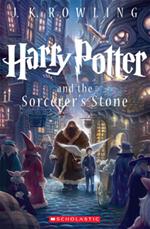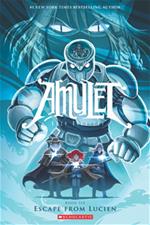 Kazu Kibuishi has had quite a year. It's hard to cover everything with just five questions, considering he battled a life-threatening illness that landed him in the hospital for weeks, illustrated the 15th anniversary edition box set of Harry Potter and produced Amulet 6, the next installment of his wildly popular graphic novel series. It may have been a long road for Kibuishi, but we couldn't be happier to see him back and reflecting on how his work affects classrooms everywhere.
Kazu Kibuishi has had quite a year. It's hard to cover everything with just five questions, considering he battled a life-threatening illness that landed him in the hospital for weeks, illustrated the 15th anniversary edition box set of Harry Potter and produced Amulet 6, the next installment of his wildly popular graphic novel series. It may have been a long road for Kibuishi, but we couldn't be happier to see him back and reflecting on how his work affects classrooms everywhere.
Amulet 6: Escape from Lucien is set to release Aug. 26. Why was this book difficult to produce?
Between Amulet 5 and 6, so much has happened. Where do I begin? Soon after the completion of Amulet 5, I got so sick that I was in the hospital for weeks. I was put in a coma for treatment for bacterial meningitis and when I woke up, I lost so much of my memory and my basic motor skills, and it took months to recover. Not long after that, I was asked to illustrate the Harry Potter 15th anniversary covers. I wasn't capable of drafting story material during this period, so the Harry Potter project came along at the perfect time, acting as a sort of cognitive therapy. My short term memory was compromised, so I couldn't remember what I read only 15 minutes after reading it, but my long-term memory seemed to be mostly intact, and I was able to channel my old memories of the series while painting. By the time I was done with the Harry Potter covers and box set, I was mostly recovered and was able to get back to working at a high level on Amulet 6. The writing was difficult because the story features so many characters now, and deciding who gets space in the book is probably the most difficult part of crafting this story.
We're so glad you got your health back! We know many teachers look forward to using the latest installment of the Amulet series in their classrooms. Why do you think it works for them?
 I like to tell parents and teachers that classic literature is simply popular entertainment that was popular long ago. And kids who are reluctant readers are simply readers who haven't found a story that engages them. Everyone loves a good story, but not everyone is willing to admit that they can't understand something they've read. What worked so well for a young reader in the 1970s is not always going to work quite as well for kids today. I try to take all of the things that I love about modern entertainment and fuse it with all the things I love about classic literature. I just try to find the connective tissue between generations so that people of all ages can find a shared love for something they all enjoy reading.
I like to tell parents and teachers that classic literature is simply popular entertainment that was popular long ago. And kids who are reluctant readers are simply readers who haven't found a story that engages them. Everyone loves a good story, but not everyone is willing to admit that they can't understand something they've read. What worked so well for a young reader in the 1970s is not always going to work quite as well for kids today. I try to take all of the things that I love about modern entertainment and fuse it with all the things I love about classic literature. I just try to find the connective tissue between generations so that people of all ages can find a shared love for something they all enjoy reading.
 You had the opportunity to create the cover art for the Harry Potter 15th anniversary box set. What was it like to visually re-imagine something so iconic?
You had the opportunity to create the cover art for the Harry Potter 15th anniversary box set. What was it like to visually re-imagine something so iconic?
It was so much fun! I don't think any artist can ever expect to be a part of a project like this, and even while I was submitting samples to Scholastic, it didn't seem possible that I would be working on it. In fact, I honestly thought I was a bad choice for the project! My initial reaction was "I don't think anyone should redo the covers, and I feel bad for the poor sap who has the responsibility to do it." You can credit David Saylor for having the vision to bring this together. It only dawned on me while I was already working on the covers that I might actually be a good fit for this project.
How has the perception of graphic novels changed over your career?
I was pretty accustomed to people thinking of comics as a black hole for a young artist's career and saw artists fleeing from the comics industry to work at animation studios. Thankfully this is something I already went through in my early teens, choosing to study film production instead of comics, and I worked in animation right out of college. So when everyone was fleeing comics for film, I was coming back the other way. In my early 20s I decided there was a real need for good all-ages comics and thought I was a good candidate to fill that need. Since that time, a number of developments in graphic novels have really allowed it to flourish and the landscape is completely different. I seem to be looked at as an old veteran now and I'm only 36.
From the perspective of the readers, they are being introduced to book-length comics at a very early age now that there are options. I would credit Bone by Jeff Smith and Scholastic Graphix for being the trailblazers for this new era of all-ages comics.
 You've said graphic novels take a lot of planning before they are created in print. How will the Amulet series will end?
You've said graphic novels take a lot of planning before they are created in print. How will the Amulet series will end?
I actually do have an ending in mind for Amulet, but so many things have changed in the story as things have progressed, so the ending continues to evolve. In many ways, I'm a spectator just like the readers. The characters guide me, and I just try to set the stage for them. What generally happens is that the ideas I have planned get layered with new ones and the information builds up into a rich cake by the time the book is ready to bake in the oven. If I do my job properly, it will seem like I could not have possibly planned it all—and that is mostly true.
April Hall is editor of ReadingToday Online. She can be reached at ahall@/.